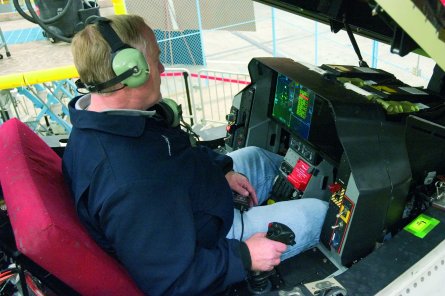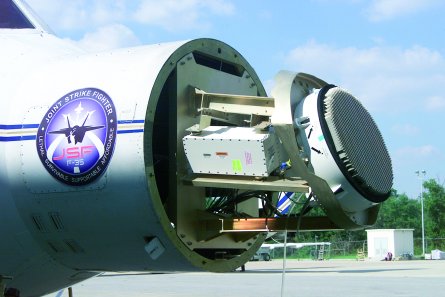By Graham Warwick in Fort Worth
Ground laboratories and flying testbeds will play a key role in ensuring the F-35 is ready for productive flight testing at sites across the USA
A pathfinder for manufacturing of the JSF, aircraft AA-1 will also pave the way for flight testing of the 14 development F-35s that follow, blazing a trail from Fort Worth in Texas to the US Air Force test centre at Edwards AFB in California and US Navy test centre at NAS Patuxent River in Maryland.
“AA-1 is the only aircraft in the original configuration, but the differences are not visible and it is very representative for the type of flight-test tasks planned,” says Tom Burbage, Lockheed Martin executive vice-president and general manager F-35 programme integration. AA-1 will evaluate aerodynamic performance, flying qualities and systems over two years of flying before handing over the test baton to the optimised-airframe F-35s that follow.
|
|---|
| The APG-81 radar has already flown on Northrop's BAC testbed |
“AA-1 is an outstanding learning tool. It allows us to go fly and collect real data,” says Doug Pearson, Lockheed vice-president F-35 integrated test force. “AA-1 will do a lot of performance work, evaluate vehicle systems and basic flying qualities, validate our analytical tools, demonstrate credibility and build confidence,” he says. “We will take it to Edwards and Pax and get their infrastructure up and running.”
Although looking complete when it rolled off the assembly line in February, AA-1 was not ready to fly. After fuel system testing and structural coupling and ground vibration tests, the aircraft is in the final build – or “box swap” – phase, where flight-qualified parts not available earlier are being installed. While there are “orders of magnitude fewer such issues” than in previous programmes, final build will continue to the end of July, says Pearson.
Once completely built, the aircraft will be powered up for another system check-out, the integrated power package (IPP) will be started, then the engine, and the aircraft will be ready to begin taxi tests. “There is 40-45 manufacturing days of negative float, which we have had for a year. If we do not recover that, we will fly in late October,” says Burbage. The company had set an internal “challenge” date of 28 August for the first flight, but “it’s remarkable we’re as close as we are”, says Pearson.
“We were in and out of the fuel barn ahead of schedule,” he says. The 46 fuel probes and electrical harnesses were checked, and some replaced, but the tests were “extremely successful”, he says. “The first aircraft built usually leaks, but this did not. And manufacturing debris in the tanks is typical, but there was none. We had to flush the F-22 fuel system 70 times to get it clean, but after only 27 times the F-35 was below 200 microns.”
Structural coupling tests were also completed ahead of schedule. In these pilot-in-the-loop tests, the aircraft’s flight controls were used to excite structural vibration, to see how the control system reacted to aircraft motion. “We refined the filters in the flight control system, but few changes were required, which built confidence,” says Pearson. Ground vibration tests, to demonstrate flutter resistance, were also finished early, with no significant findings.
Software progress
Software development is progressing in parallel with work on the aircraft. “AA-1 is running with the ground software load,” says Pearson. “We get one more load to start the IPP and the engine, then we get the flight clearance load. It’s running in the lab and on track for the end of October.” AA-1 will have about 80% of the vehicle system software planned for the F-35, but none of the mission system software.
 © Lockheed Martin |
|---|
| F-35 chief test pilot Jon Beesley flies AA-1 during ground tests |
Vehicle system software, including flight controls, utilities and displays, involves around a million lines of code in AA-1 – the fully operational F-35 will have 6 million lines. The software will be released in phases, beginning with Block 0.1 in AA-1, 0.1A in the first STOVL aircraft, BF-1, and 0.1B in the first CV aircraft, CF-1.
The first F-35 with mission-system software will be BF-3, the third STOVL aircraft, due to fly April 2008. “Block 0.5 is the first mission-system software load, and is not ‘go to war’,” says Burbage. “Block 1 could go to war, and provides an early versus full capability.” All hardware will be in the aircraft by Block 1, and subsequent upgrades will be software-only. Block 2 will introduce additional weapons, sensor fusion and prognostic health management (PHM). Block 3 is the full-up capability planned for the end of system development and demonstration.
“The labs are full for AA-1. We are done with testing functionality and the software for flight test will be ready within the next two months,” says Bobby Williams, air vehicle team lead. “AA-1 is the pathfinder for the software process. It has proved the development toolsets, release processes and test procedures. It has driven the team to get the labs up and running early in the programme.”
About the same time that AA-1 is due to fly, a Boeing 737 is expected to arrive at Fort Worth from BAE’s Flight Systems division in Mojave, California where it is being converted to the Cooperative Avionics Test Bed (CATB), or “CATBird”. Modified to mimic the F-35 by mounting sensors and apertures in almost exact alignment, using the same cable lengths and power systems, the 737 will have 20 engineering stations and an F-35 cockpit simulator on board.
Initial flights will validate the structural modifications, including radar nose and stub wing, after which systems will be installed and the CATBird will begin flying as an avionics laboratory early next year. Beginning with the BAE Systems North America-supplied electronic-warfare system, each element will be flight-tested independently, and then integrated, to clear the mission-system software for F-35 flight.
AESA radar
“All the sensors have already flown on surrogate aircraft, and all are now in the lab being integrated,” says Burbage. This includes the APG-81 active electronically scanned array (AESA) radar developed by Northrop Grumman Electronic Systems, and the distributed aperture system (DAS) and electro-optical targeting system (EOTS) developed jointly with Lockheed Martin Missiles & Fire Control.
AESA, DAS, EOTS and EW will fly together on the CATBird. “This is the first time we will fly a testbed that is fully integrated. Previous testbeds were federated and tested one system at a time” says Burbage. “We will test all the software, including fusion, up to the full Block 3 configuration. The only thing this aircraft will not replicate is high manoeuvrability.”
Aircraft AA-1 will get F-35 flight tests rolling, but at a relatively slow pace and largely as a risk-reduction tool. Initial airworthiness flights will be limited to 350kt (650km/h) and 4g, after which the aircraft will stand down for proof-load tests, during which the software will be updated and the helmet-mounted display (HMD) installed, says Williams.
The first STOVL aircraft, and first optimised airframe – BF-1 – is set to fly in February 2008. After initial “up-and-away” flights to confirm flying qualities, work will focus on hover testing and BF-1 will stay at Fort Worth for six months, says Pearson. During 2008 and 2009, BF-1 to -5 will go to Pax River for testing, followed by CV aircraft CF-1 to -4, while CTOL aircraft AF-1 to -5 will go to Edwards.
Although an orphan because of design changes, AA-1 has a key role to play in wringing out the basic aircraft systems ahead of JSF flight testing at Edwards and Pax River. “Each aircraft we deliver should be a full-up test article, and not just an aircraft to fly,” says Pearson. “We have to do things now to prepare for success flight test. If we wait till the aircraft get on ramp, it will be too late.” ■
Source: Flight International




















